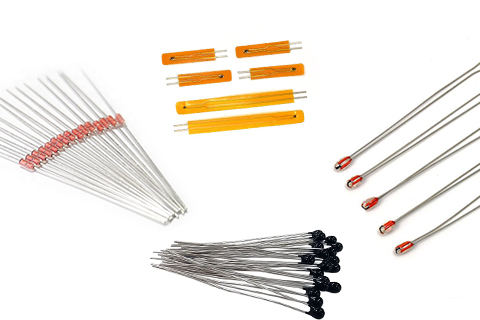Temperature sensors play an important role in the world. NTC (Negative Temperature Coefficient) sensors are widely used in many applications, ranging from home appliances like refrigerators to automotive systems, medical devices, and industrial equipment. It is important to know how to choose the right NTC sensor. There are some details to consider. The tips for selecting NTC sensor:
1. Temperature Range
NTC sensors are available in different temperature ranges to accommodate various applications. When choosing the right sensor, it’s essential to ensure that its operating temperature range matches the temperature conditions it will be exposed to.
For instance, if you are using the sensor in an application where temperatures will vary from -10°C to 50°C, make sure that the NTC sensor you choose has an operating range that covers this spectrum. An NTC sensor with a temperature range that is either too narrow or too wide for your application might not deliver optimal results.
2. Resistance Value
NTC sensors come in various resistance values at a reference temperature, usually 25°C. The resistance value at this temperature determines the sensor’s sensitivity and how it responds to temperature changes. Common resistance values include:
1kΩ: This is suitable for applications requiring lower sensitivity.
10kΩ: This is the most common value used in many general applications, including air conditioning, refrigeration, and automotive systems.
100kΩ: These sensors have a higher sensitivity to temperature changes, making them ideal for high-precision applications.
3. Sensor Size and Form Factor
The size and form factor of the NTC temperature sensor are other important considerations. NTC sensors come in various shapes, sizes, and designs, such as:
Probes: These sensors are typically used in applications where the sensor needs to be immersed in a liquid or air for temperature measurement.
Discs: Disc-shaped NTC sensors are often used for surface temperature monitoring in appliances like refrigerators or ovens.
Surface-Mounted Versions: These are designed for easy integration into electronic circuits and are typically used in devices where space is limited.
4. Response Time
In some applications, the response time of the NTC temperature sensor is a critical factor. For instance, in air conditioning, automotive systems, or HVAC systems, fast response times are crucial because these systems need to quickly react to temperature changes to maintain efficiency and ensure comfort or safety.
NTC sensors with faster response times provide more accurate readings, reducing the lag between a temperature change and the system’s ability to react. If your application involves frequent or rapid temperature fluctuations, selecting a sensor with a quick response time is essential.
For example, if you’re using an NTC sensor in an automotive engine, it’s important that the sensor responds quickly to temperature changes to prevent overheating. Similarly, in smart home systems where temperature changes can happen frequently, a sensor with a fast response time will help maintain consistent performance.
5. Accuracy
The accuracy of the NTC temperature sensor is another critical factor, especially for applications where precise temperature readings are essential. For instance, medical devices or laboratory instruments demand high-accuracy sensors that can detect even small changes in temperature.
Most NTC sensors offer accuracy within ±1°C, which is sufficient for many general applications. However, for highly sensitive applications, such as food storage, medical devices, or environmental monitoring, you might need sensors with a higher degree of accuracy (within ±0.5°C or even more precise).
Before selecting a sensor, you should assess the tolerance requirements of your application and determine the level of accuracy needed. For highly demanding applications, opt for sensors with high precision, but if general accuracy is sufficient, a standard NTC sensor will work well.
6. Environmental Conditions
NTC sensors are often exposed to harsh environmental conditions, such as extreme temperatures, high humidity, vibrations, and chemical exposure. Therefore, it’s essential to consider the environmental conditions where the sensor will be used.
Some sensors come with protective coatings or waterproof features to withstand such conditions. For example:
Waterproof NTC Sensors: These sensors are ideal for use in humid or wet environments, such as in refrigerators, dishwashers, or washing machines.
Vibration-Resistant Sensors: For automotive or industrial applications, choosing sensors designed to handle vibrations and shocks is critical.
Corrosion-Resistant Sensors: In applications exposed to chemicals, corrosion-resistant sensors are a must.
By understanding the specific environmental challenges your NTC sensor will face, you can select a sensor that is protected against damage and performs reliably under those conditions.
7. Long-Term Stability and Reliability
NTC sensors are generally reliable, but their performance can degrade over time due to factors such as aging or thermal cycling. It’s essential to select a sensor that can provide long-term stability, particularly if it will be used in critical systems. Look for sensors that have been tested for long-term reliability and that come with a warranty or certifications for quality.
Some sensors may experience slight shifts in resistance over time, which can affect their accuracy. Choosing high-quality sensors with stable long-term performance is vital to maintaining the consistency and reliability of your system. Choosing the right NTC temperature sensor is vital for ensuring the proper operation of your system and achieving accurate temperature measurements. By considering factors such as temperature range, resistance value, sensor size, response time, accuracy, environmental conditions, and long-term stability, you can make an informed decision that suits your application’s requirements.
Whether you’re working in automotive, medical, appliance, or industrial applications, understanding the various options available will help you select the most suitable sensor for your needs. By carefully evaluating your specific needs and matching them with the right NTC sensor, you can ensure optimal performance, increased reliability, and long-lasting results.





